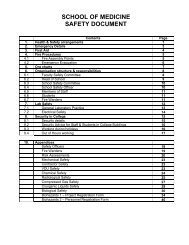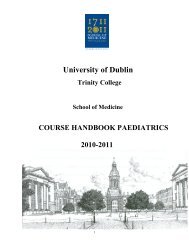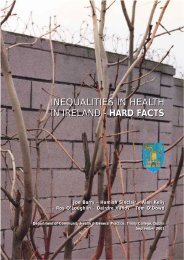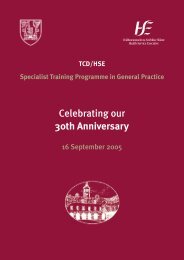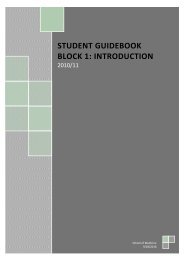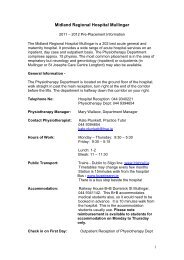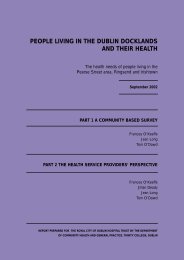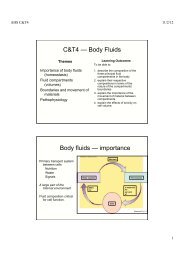people living in finglas and their health - School of Medicine - Trinity ...
people living in finglas and their health - School of Medicine - Trinity ...
people living in finglas and their health - School of Medicine - Trinity ...
You also want an ePaper? Increase the reach of your titles
YUMPU automatically turns print PDFs into web optimized ePapers that Google loves.
RESULTS - PART 1<br />
RESULTS - PART 1<br />
Results<br />
Figure 3.1 Age pr<strong>of</strong>ile <strong>of</strong> the population <strong>in</strong> 1996 census versus household members <strong>in</strong> 2002 survey<br />
3.0 INTRODUCTION<br />
CENSUS<br />
SURVEY<br />
The results <strong>of</strong> the survey are presented <strong>in</strong> twelve sections:<br />
3.1 Response rate.<br />
3.2 Demographic <strong>and</strong> socio-economic characteristics <strong>of</strong> the:<br />
• participat<strong>in</strong>g households,<br />
• primary carers (respondents),<br />
•<strong>in</strong>dividual members <strong>in</strong> each <strong>of</strong> the participat<strong>in</strong>g households.<br />
PERCENTAGE<br />
20<br />
17.0 17.3<br />
16.5<br />
16.8<br />
15.9<br />
16.3<br />
14.1<br />
15<br />
13.9<br />
12.7 12.4<br />
12.6<br />
12.6<br />
10.6<br />
11.3<br />
10<br />
5<br />
0<br />
0-9 10-19 20-29 30-39 40-49 50-64 65 or more<br />
AGE (IN YEARS)<br />
3.3 Health care issues<br />
• stress <strong>and</strong> violence <strong>and</strong> <strong>health</strong> related behaviours (<strong>in</strong>clud<strong>in</strong>g cigarette smok<strong>in</strong>g <strong>and</strong> substance misuse).<br />
3.4 Chronic disease.<br />
3.5 Disability.<br />
3.6 Deaths.<br />
3.7 Acute hospital services.<br />
3.8 Health services for women.<br />
3.9 Community <strong>health</strong> services<br />
• <strong>in</strong>clud<strong>in</strong>g general practice, community nurs<strong>in</strong>g, pharmacy services <strong>and</strong> dental services.<br />
3.10 Wait<strong>in</strong>g for <strong>health</strong> care.<br />
3.11 Primary carers’ sources <strong>of</strong> <strong>health</strong> <strong>in</strong>formation.<br />
3.12 Primary carers’ suggested additional <strong>health</strong> needs.<br />
All f<strong>in</strong>d<strong>in</strong>gs are as reported by the primary carer (the person <strong>in</strong> the household who manages the welfare <strong>and</strong><br />
<strong>health</strong> <strong>of</strong> the family/household) <strong>in</strong> each household.<br />
3.1 RESPONSE RATE<br />
Of the 420 households <strong>in</strong>vited to participate <strong>in</strong> the survey, 325 (77%) agreed to be <strong>in</strong>terviewed. Seventy-seven<br />
households (18.3%) did not wish to be <strong>in</strong>terviewed while 18 (4.3%) households were not accessed (despite a<br />
m<strong>in</strong>imum <strong>of</strong> four return visits). The response rates were similar <strong>in</strong> geographical areas that were classified as<br />
more deprived compared with the areas classified as less deprived (160/210, 76% versus 165/210, 78%;<br />
p=0.6).<br />
Figure 3.2 Gender pr<strong>of</strong>ile <strong>of</strong> the population <strong>in</strong> 1996 census versus household members <strong>in</strong> 2002 survey<br />
PERCENTAGE<br />
52<br />
51<br />
50<br />
49<br />
48<br />
47<br />
48..8<br />
MALE<br />
51.0<br />
Analysis perta<strong>in</strong><strong>in</strong>g to the households <strong>and</strong> primary carers refers to <strong>in</strong>formation ascerta<strong>in</strong>ed from the 325 primary<br />
carers who took part <strong>in</strong> the survey. The 325 primary carers also provided <strong>in</strong>formation on the 963 <strong>in</strong>dividuals<br />
(<strong>in</strong>clud<strong>in</strong>g themselves) who resided <strong>in</strong> the participat<strong>in</strong>g households. Denom<strong>in</strong>ators vary because not all the<br />
respondents answered all the questions.<br />
3.2 DEMOGRAPHIC AND SOCIO-ECONOMIC CHARACTERISTICS<br />
Demographic <strong>and</strong> socio-economic characteristics at the household level<br />
Table 3.1 presents the household characteristics as reported by the primary carers. On average, three<br />
<strong>in</strong>dividuals lived <strong>in</strong> each house. Over one quarter <strong>of</strong> the households were <strong>liv<strong>in</strong>g</strong> <strong>in</strong> the area for less than ten years<br />
<strong>and</strong> the majority <strong>of</strong> these (51/86, 59%) had moved <strong>in</strong>to the area with<strong>in</strong> the last five years. Over two fifths <strong>of</strong> the<br />
households were outright owners <strong>and</strong> three out <strong>of</strong> every ten households were repay<strong>in</strong>g a mortgage while almost<br />
twelve percent <strong>of</strong> the households resided <strong>in</strong> government supported accommodation. Irish nationals occupied<br />
almost all the households (98%) (Figure 3.3).<br />
51.2<br />
CENSUS<br />
FEMALE<br />
49.0<br />
SURVEY<br />
The age pr<strong>of</strong>ile for the <strong>in</strong>dividual household members was significantly different from that reported <strong>in</strong> the 1996<br />
census, p=0.005 (Figure 3.1). There was a lower proportion <strong>of</strong> household members <strong>in</strong> the 10 to 19 year age<br />
group <strong>and</strong> a higher proportion <strong>in</strong> the 65 years or more age group compared to the census population. The<br />
gender pr<strong>of</strong>ile was similar, p=0.2 (Figure 3.2).<br />
20<br />
21






